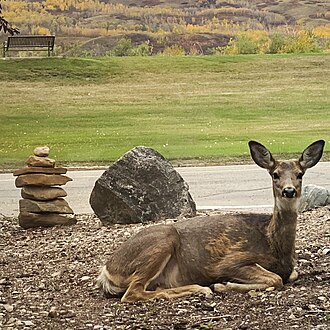White-tailed deer






White-tailed deer (Odocoileus virginianus), also known as the Virginia deer, is a medium-sized deer native to the United States, Canada, Mexico, Central America, and South America as far south as Peru and Bolivia. It has also been introduced to New Zealand, Cuba, Jamaica, Hispaniola, Puerto Rico, Bahamas, the Lesser Antilles, and some countries in Europe, such as Finland and the Czech Republic. The species is highly adaptable and can live in a variety of habitats, including forests, farmland, brushy areas, and swamps.
Description[edit]
The white-tailed deer is easily recognizable by its namesake white underside to its tail, which it displays prominently when alarmed or running. Adult size varies across its range; northern populations are typically larger than those in the tropics. Males (bucks) are larger than females (does) and have antlers that are shed and regrown annually. The coat is reddish-brown in the summer, turning to a grey-brown throughout the winter months.
Behavior[edit]
White-tailed deer are primarily crepuscular, being most active during the dawn and dusk. They are herbivores, feeding on a wide variety of vegetation, including shoots, leaves, cacti, and grasses. The species is known for its ability to adapt to different food sources in different environments. Social structure varies widely, with some populations displaying complex social structures, while others are more solitary.
Reproduction[edit]
Breeding season, or the rut, occurs in the fall, with timing varying by geographical location. During this time, bucks will compete for the opportunity to mate with does. After a gestation period of approximately 200 days, does will give birth to one to three fawns in the spring. Fawns are born with white spots that help camouflage them from predators.
Conservation Status[edit]
The white-tailed deer is classified as Least Concern by the International Union for Conservation of Nature (IUCN), due to its wide distribution and large populations. However, local populations can be affected by habitat loss, hunting, and vehicle collisions. In some areas, white-tailed deer populations have increased to the point where they are considered a pest due to their impact on agriculture and forestry.
Human Interaction[edit]
White-tailed deer have a significant impact on human economies and cultures. They are a popular game animal, with hunting regulated by state and provincial wildlife agencies. In some areas, deer overpopulation has led to increased vehicle collisions and damage to crops and landscaping. Efforts to manage deer populations include hunting, contraception, and habitat management.
Ad. Transform your life with W8MD's Budget GLP-1 injections from $75


W8MD offers a medical weight loss program to lose weight in Philadelphia. Our physician-supervised medical weight loss provides:
- Weight loss injections in NYC (generic and brand names):
- Zepbound / Mounjaro, Wegovy / Ozempic, Saxenda
- Most insurances accepted or discounted self-pay rates. We will obtain insurance prior authorizations if needed.
- Generic GLP1 weight loss injections from $75 for the starting dose.
- Also offer prescription weight loss medications including Phentermine, Qsymia, Diethylpropion, Contrave etc.
NYC weight loss doctor appointmentsNYC weight loss doctor appointments
Start your NYC weight loss journey today at our NYC medical weight loss and Philadelphia medical weight loss clinics.
- Call 718-946-5500 to lose weight in NYC or for medical weight loss in Philadelphia 215-676-2334.
- Tags:NYC medical weight loss, Philadelphia lose weight Zepbound NYC, Budget GLP1 weight loss injections, Wegovy Philadelphia, Wegovy NYC, Philadelphia medical weight loss, Brookly weight loss and Wegovy NYC
|
WikiMD's Wellness Encyclopedia |
| Let Food Be Thy Medicine Medicine Thy Food - Hippocrates |
Medical Disclaimer: WikiMD is not a substitute for professional medical advice. The information on WikiMD is provided as an information resource only, may be incorrect, outdated or misleading, and is not to be used or relied on for any diagnostic or treatment purposes. Please consult your health care provider before making any healthcare decisions or for guidance about a specific medical condition. WikiMD expressly disclaims responsibility, and shall have no liability, for any damages, loss, injury, or liability whatsoever suffered as a result of your reliance on the information contained in this site. By visiting this site you agree to the foregoing terms and conditions, which may from time to time be changed or supplemented by WikiMD. If you do not agree to the foregoing terms and conditions, you should not enter or use this site. See full disclaimer.
Credits:Most images are courtesy of Wikimedia commons, and templates, categories Wikipedia, licensed under CC BY SA or similar.
Translate this page: - East Asian
中文,
日本,
한국어,
South Asian
हिन्दी,
தமிழ்,
తెలుగు,
Urdu,
ಕನ್ನಡ,
Southeast Asian
Indonesian,
Vietnamese,
Thai,
မြန်မာဘာသာ,
বাংলা
European
español,
Deutsch,
français,
Greek,
português do Brasil,
polski,
română,
русский,
Nederlands,
norsk,
svenska,
suomi,
Italian
Middle Eastern & African
عربى,
Turkish,
Persian,
Hebrew,
Afrikaans,
isiZulu,
Kiswahili,
Other
Bulgarian,
Hungarian,
Czech,
Swedish,
മലയാളം,
मराठी,
ਪੰਜਾਬੀ,
ગુજરાતી,
Portuguese,
Ukrainian
